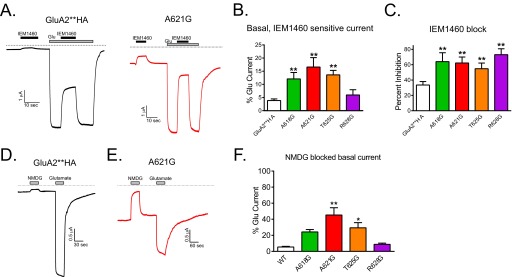FIGURE 4.

The A621G mutant has basal, agonist-independent activity. A, sample traces showing that the pore channel blocker IEM1460 (10 μm) has little effect on GluA2**HA in the absence of glutamate and blocks the channels after glutamate (100 μm)-induced activation. In contrast, the A621G channel has a large basal current that is blocked by IEM1460, and after glutamate activation, the channel is robustly blocked by IEM1460. B, summary data for IEM1460 effect on basal current in pore-lining glycine mutants (n = 7–26; **, p < 0.01 compared with GluA2**HA, one-way ANOVA with Dunnett's post hoc test). C, summary data for IEM1460 effect on glutamate-induced currents in pore-lining glycine mutants (n = 7–26; **, p < 0.01 compared with GluA2**HA, one-way ANOVA with Dunnett's post hoc test). D, sample trace showing that replacing sodium with NMDG does not significantly affect activity in the absence of agonist in GluA2**HA. E, replacing sodium in the recording buffer with the impermeant NMDG blocking the current in the absence of glutamate for oocytes expressing A621G. F, summary data showing the extent of NMDG-blocked basal current expressed as percentage of the glutamate-induced current in the same oocyte for GluA2**HA and the pore glycine mutants (n = 5–7; *, p < 0.05 compared with GluA2**HA, one-way ANOVA with Dunnett's post hoc test).
